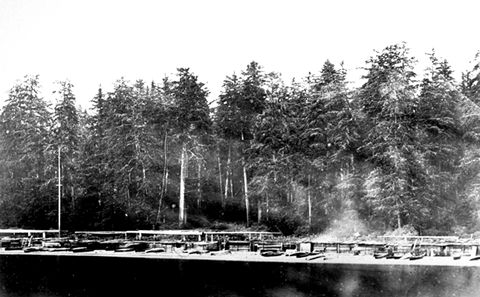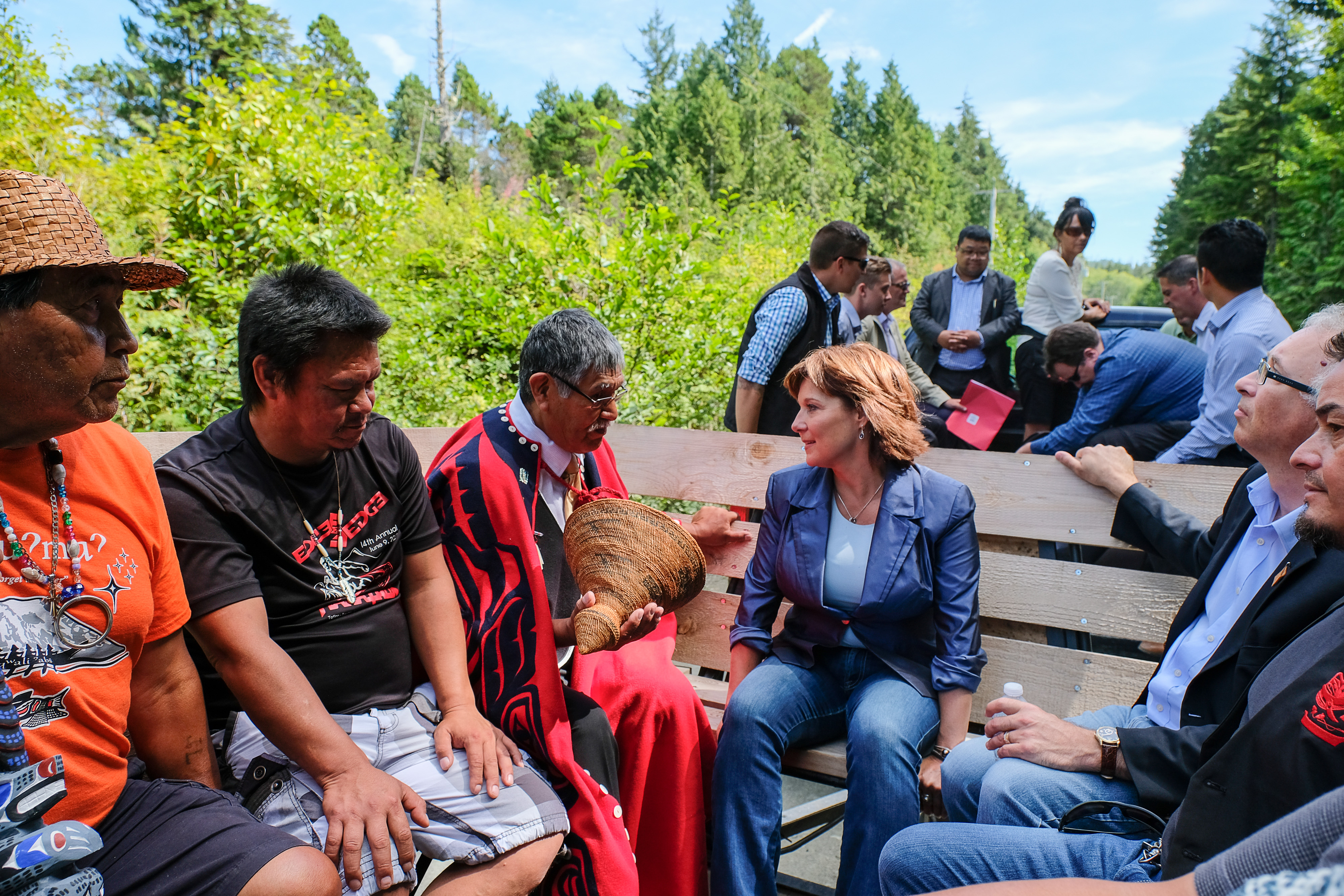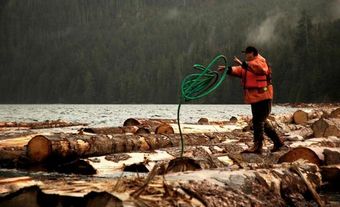Ahousaht (Ahousat) is a Nuu-chah-nulth First Nation residing on the west coast of Vancouver Island, British Columbia. The word Ahousaht means “facing opposite from the ocean” or “people living with their backs to the land and mountains” in the Nuu-chah-nulth language. It is the largest of all the Nuu-chah-nulth nations, with a population of 2,224 in 2021.
Territory and Population
Historically, the Ahousaht were a small nation located on the outer coast of Vargas Island in British Columbia. In the early 19th century, the Ahousaht, with firearms obtained from other Indigenous kinsmen, likely Nuchatlaht and Mowachaht, conquered the much larger Otsosaht nation and took their territories of Flores Island, Millar Channel and Herbert Inlet. As a result of warfare, intermarriage and other factors, the Ahousaht absorbed some neighbouring nations, including the Otosaht, the Manhousaht of Sydney Inlet and Shelter Inlet, and the Kelsomaht of the east coast of Vargas Island. These nations formally amalgamated with the Ahousaht in the 20th century.
Today, Ahousaht territory is located between the lands of the Hesquiaht to the north and the Tla-o-qui-aht to the south. The most populated Nuu-chah-nulth nation, Ahousaht has 2,224 members and 25 reserve sites. About one third of Ahousaht members live on traditional territory.
Traditional Life
Prior to the arrival of Europeans, the Ahousaht were a fishing community. Fishing — particularly salmon fishing — still remains an integral part of their contemporary economy. Like other Nuu-chah-nulth nations, the Ahousaht travelled by canoe and on foot to get to and from hunting and fishing sites.
Social Organization
Ahousaht society is governed by hereditary chiefs (hawiih) who are also responsible for traditional lands and resources (hahuulthi). Since the Indian Act only recognizes elected chiefs, the Ahousaht nation operates with both elected and hereditary chiefs. This hybrid system includes three principle hereditary chiefs, one elected chief and an elected council.
Culture

A Nuu-chah-nulth nation, the Ahousaht have a strong ceremonial culture, characterised by feasting and entertainment with song, dance, contests and theatricals (seePotlatch). One popular ceremonial dance performed by the Ahousaht at social gatherings is the paddle dance. Performers hold hand-carved, wooden paddles, at times swaying them in a sweeping fashion, symbolizing the paddles’ motion through waters.
Whaling was a significant cultural practice as well as an important economic venture for the Ahousaht and some other Indigenous nations living along the Pacific Northwest Coast ( see Indigenous People: Northwest Coast).
The Ahousaht, much like other Nuu-chah-nulth, are known for their stunning woodwork, including canoes, totem poles, multifamily houses and other products hand-crafted out of fine cedar (see Northwest Coast Indigenous Art). A couple of well-known Ahousaht artists are Ike Charlie and Qwaya Sam, both of whom are carvers.
Religion and Spirituality
The Nuu-chah-nulth belief system centres on a Creator being as well as spirits whose powers can be used to bring peace and fortune. The Nuu-chah-nulth believe that all life forms have a spirit, and should therefore be respected and appreciated. Shamans ensured the spiritual health of the people by practising ancient medicines and healing rituals to cure illness and restore balance to the soul.
Origin Stories
Nuu-chah-nulth stories and legends speak of their past and are used to pass on traditional knowledge to future generations. Most creation stories speak of the Creator who made the lands, waters, creatures and people. Nuu-chah-nulth stories also tend to feature important cultural figures, such as Raven and Mink, both of whom help the people to adapt to their surroundings. (See also Raven Symbolism).
Language
The Ahousaht speak Central Nuu-chah-nulth (Nuučaan̓uɫ), which is part of the Wakashan language family. The Ahousaht also speak their own dialect of this language, which is endangered. According to the First Peoples Language Map of British Columbia, there are only about 40 fluent speakers, 15 people who somewhat understand the language and an additional 40 learning speakers. ( See alsoNorthwest Coast Language Families and Nuu-chah-nulth: Language).
Traditional Laws and Rights
The Ahousaht and other Nuu-chah-nulth nations have traditional laws that were superseded in Canadian law by the Indian Act. However, Ahousaht customs surrounding law and justice have survived and are still used today. In one noted example in 2010, Ahousaht leaders threatened members accused of drug and alcohol abuse with banishment if they did not live a clean life. Indigenous leaders argue that traditional laws and other cultural customs can be key to healing individuals and communities.
The Ahousaht have fought to protect their traditional rights to fishing in provincial courts. On 3 November 2009, the B.C. Supreme Court decided that, in the case of Ahousaht Nation v. Canada, the Indigenous plaintiffs had the right to fish in their traditional territories and sell those fish in the commercial marketplace. This is the first case of Indigenous fishing rights in Canada that did not limit the Ahousaht’s fishing rights to a specific species of fish.
Colonial History
Nuu-chah-nulth nations first made contact with European traders in the 1700s. Increased European settlement on traditional Nuu-chah-nulth territories in the 19th century displaced the Ahousaht and others onto reserves.
In 1895, the Presbyterian Church established the Ahousaht Day School (which became a residential school in 1903) just south of the Maktosis reserve. Like other residential schools, students were forced to assimilate into white, Christian, Canadian culture, and to abandon their Indigenous language and customs. The school burned down in 1940. The Truth and Reconciliation Commission currently works to bring awareness about the dark history of residential schools in Canada to the general public, as well as to help heal relationships between Indigenous and non-Indigenous peoples.
Contemporary Life
Today, the majority of Ahousaht live in the village of Maaqtusiis (Maktosis), also known as “Ahousat.” Many Ahousaht members also live in Port Alberni, Nanaimo, Victoria and other locations on Vancouver Island and beyond.
In early 2010, the Ahousaht entered into an economic partnership with Cermaq Canada, an international salmon farming company that operates in Ahousaht territory. Although there has been some controversy surrounding these agreements in the community, the partnership claims to seek long-term benefits for both parties.
The Ahousaht are also part of the Nuu-chah-nulth Tribal Council (previously known as the West Coast Allied Tribes), an association founded in 1958 that provides various services to approximately 9,500 registered members, including child welfare, education, employment training and other socio-economic programs that support health and development.
On 25 October 2015, a whale-watching ship called the Leviathan II capsized, drowning six people. Ahousaht people and Tofino community members rescued survivors, collecting them in their boats and water taxis. For their heroism, the premier of British Columbia, Christy Clark, presented the Tofino and Ahousaht communities with the B.C. Medal of Good Citizenship in August of the following year. The premier also promised $50,000 in emergency response and preparation funding.
In an effort to address high unemployment rates in Ahousaht, the province of British Columbia and the Ahousaht First Nation signed an economic agreement on 12 August 2016. The deal is to provide $1.25 million over five years to support Ahousaht leaders in improving economic opportunities in their community.

 Share on Facebook
Share on Facebook Share on X
Share on X Share by Email
Share by Email Share on Google Classroom
Share on Google Classroom








